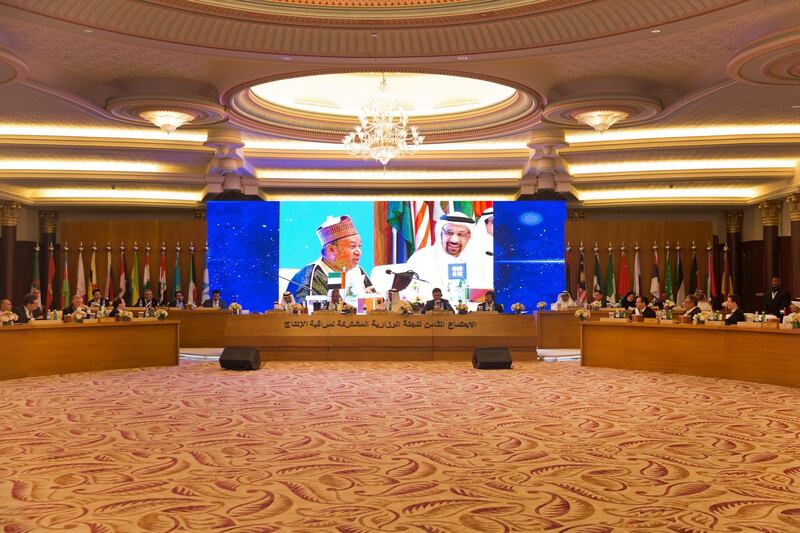“In 1996, I thought $20 a barrel was reasonable; in 2006 I thought $27 a barrel was reasonable and now it is around $100 a barrel. I told them again it is reasonable," said former Saudi oil minister Ali Al Naimi in 2013.
The plunge the following year took prices all the way back to $27 by February 2016. Now, with Brent crude at $74 on Thursday, the leading oil exporters are again braking their oil output too hard.
US President Donald Trump responded to Opec’s latest monitoring committee meeting in his usual style: “Looks like OPEC is at it again…Oil prices are artificially Very High!” he tweeted. Stories circulating beforehand suggested Saudi Arabia might be seeking prices of $80 or even $100 per barrel.
There are three problems with the Opec/non-Opec coalition’s current approach. Compliance is too high, and is not adjusted for some members’ inability to maintain production. The group’s metrics for assessing their deal, and hence their future guidance on policy, have become blurred. And current prices threaten demand growth, and hence risk a renewed slump.
The committee reported that Opec and its non-Opec partners had achieved record compliance to their planned cuts of 149 per cent – ie, cutting 50 per cent more than they had planned. But this is not a sign of success. The group should be aiming to hit, not exceed, its target. The over-tightening is mainly due to the continuing collapse in Venezuela, whose output is down from 1.9 million barrels per day in 2017 to less than 1.5 million bpd in March. Angola has lost another 150,000 bpd over its target because of ageing fields. Meanwhile Saudi Arabia is also producing less than its target – when it should be slightly over-producing to compensate for others’ losses.
Having declared that they have pretty much achieved their goal of bringing down Organisation for Economic Co-operation and Development oil stocks to the five-year average level, Opec has now begun casting around for a different metric to justify continuing cuts. This is not price: the Saudi Arabia and UAE energy ministers, Khalid Al Falih and Suhail Al Mazrouei, have resolutely refused to talk in terms of a specific price. Conversely, Iranian oil minister Bijan Zanganeh and Russia’s Alexander Novak, respectively, named $60 and $64 per barrel as “acceptable”.
Instead, Mr Al Falih has echoed the oil consumers’ organisation, the International Energy Agency (IEA), in pointing to the danger of a lack of investment. But this is not a guide to Opec policy: what is the right level of investment? And with investments taking several years to come to fruition, this would not be helpful for making month-by-month production decisions.
_______________
Read more:
Russia eyes an exit, while Saudi Arabia holds oil output curbs together
Despite Trump's concern an oil-price fall would carry risks
_______________
The focus on a lack of investment also contradicts Opec’s actual policy. If there is a danger of shortages, the major producers should be investing heavily in extra production capacity, to capture market share at attractive prices. Instead, the theme of underinvestment reads more like a pre-emptive defence against tweeters such as Mr Trump.
Adjusted for inflation, the oil price has been above $74 per barrel for 13 out of the 47 years of the post-1970 era of Opec power. Prices at today’s level are not unheard of, but they are unusual. The three main forecasting agencies - the IEA, the US' Energy Information Administration, and Opec itself – all see production growth outside Opec outstripping demand this year. After restoring its market share to a high in the third quarter of last year, Opec has let it slip again this year – in an environment of strong prices and demand in which it should be gaining market share.
Mr Al Naimi was later to write that, however fair $100 per barrel had been, it had been a mistake. “It was very high,” he said in his 2016 autobiography. “That price unleashed a wave of investment around the world into what had previously been uneconomic oilfields.”
He is right, but more serious for the future is the loss of demand. Under the stress of high prices, world oil demand grew less than 1.1 million barrels per year on average during 2011-14. This improved to around 1.7 million barrels per day of annual gains in 2015-17. The hoped-for $80 per barrel price would represent a near-doubling from the middle of last year, and inevitably have a negative effect on consumption.
For the longer-term, an implicit price floor of $80 or $100 is a guarantee for high-cost oilfields and electric vehicles. Once battery cars enter the mainstream, consumer familiarity and economies of scale in manufacturing and recharging will impel them much faster than early adopters and government subsidies do today - a potentially devastating threat to all oil exporters.
From here, there are two likely paths. Either weakening demand, a slowing economy and increased non-Opec production will erode prices again, requiring the group to extend its cuts into next year. Or, prices could spike as the (N)Opec coalition keeps too much oil off the market. This would worsen by the imposition of oil-related sanctions on one or more of Iran, Venezuela and Russia. This would be followed by a steeper and longer price hole. It may already be too late, but for now the best the oil exporters can do is to ease off the brakes.
Robin Mills is CEO of Qamar Energy, and author of The Myth of the Oil Crisis






